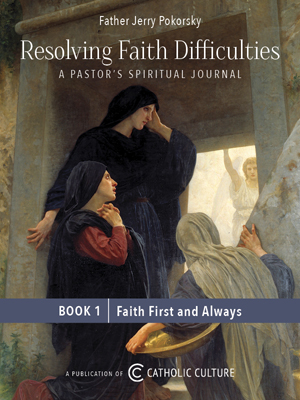Catholic Recipe: Hamantaschen
Also Called: Haman's Pockets
"The temple shall fail, but Purim never," is an old saying about a festival that traditionally was instituted in 475 B.C., when Ahasuerus, or Xerxes, was King of Persia. On the fourteenth and fifteenth of Adar-February or March in the Western calendar, and the twelfth month of the Hebrew ecclesiastical year-Jews all over the world observe Purim, the Feast of Lots. The occasion, which is one of thanksgiving and joy, is celebrated with music, merrymaking, and special foods. Purim, according to Old Testament account, marks the deliverance of the Jews, in Queen Esther's time, from the massacre their enemy, Haman, cunningly plotted. Ta'anith Esther, the Fast of Esther, on Adar 13, commemorates the queen's three days of fasting and prayer before she interceded with her husband, the king, to save her people. According to the dramatic narrative in the Megillah, or roll of Esther, which is read at Purim both in the synagogue and at home, Haman persuaded Kink Ahasuerus, to decree the slaughter of the Jews in Persia. Haman hated all Jews, but especially Mordecai, the queen's kinsman, because he refused to bow before the minister. Purim is called the Feast of Lots because Haman, a superstitious man, cast lots to determine an auspicious day for destroying the Jews.
Mordecai secretly informed Esther of the plot. So the queen invited the king and his prime minister to a banquet. She suddenly revealed Haman's scheme. The angry king ordered his prime minister to be hung from the gallows prepared for Mordecai. The story has an almost fairytale ending, for the king appointed Mordecai the new prime minister, and gave him the ring he once gave Haman. Queen Esther was hailed as savior of her people. And according to the Megillah, "the Jews . . . made the fourteenth day of the month of Adar a day of gladness and feating, and a good day."
The Purim feast has many traditional foods, including kreplah, small triangular dumplings that are dropped into boiling soup; verenikes, another kind of holiday dumpling; symbolic nahit, or chick peas, cooked in salted water and served hot or cold; poppy-seed candies, apples, raisins, and a great variety of cakes.
Hamantaschen, shiny little pouchlike buns cut into threecornered shapes and stuffed with prune paste or honeyed poppy seed, are by far the most popular of all Purim pastries. They are made at home, or baked commercially by the thousands of dozens. Parents give these cakes as presents to the youngsters, who munch them with delight. Hamantaschen, Haman's pockets, are named after the wicked prime minister, arch villain of the Purim feast and butt of Purim jokes.
There was once a wicked man, And Haman was his name, sir; He would have slaughtered all the Jews, Though theirs was not the blame, sir.
is the theme of many a popular song.
Jews of every country interpret the triangular form of the cakes in their own fashion. Haman's "donkey ears" they call them in Mediterranean countries. To German-speaking Jews the shape suggests the pocket, or purse, in which Haman stowed away the "ten thousand talents of silver" the king gave for exterminating the Jews. In some countries the cakes represent the three-cornered hat Haman supposedly wore when he became prime minister.
Purim is a time when friends and relatives exchange presents, and especially remember the aged and the needy. Children masquerade as Queen Esther, King Ahasuerus, Haman, and Mordecai, while their elders supposedly drink wine until "it is difficult to distinguish between blessing Mordecai and cursing Haman!"
The cursing of Haman takes many amusing forms. Whenever his name occurs during the synagogue services, children stamp their feet and make a horrible racket with whirling greggers, or wooden rattles. Italian Jews used to burn Haman in effigy to the accompaniment of trumpets. In many European ghettos Purim actors still go about from house to house and give humorous improvisations of the Book of Esther. The youthful performers, arrayed in gaudy bits and pieces from mother's scrap bag, sing comic verses about the wicked Haman, and collect coins "for alms."
Hamantaschen, the funny little cakes of Purim, are far too good to restrict to one occasion. Make them often-for parties or dessert. Stuff them with traditional prune or poppy-seed fillings; or vary the centers by using homemade preserves, mincemeat, or original combinations of nuts, candied peels, and mixed fruits.
DIRECTIONS
Sift together the dry ingredients. Make well in center. Break in eggs, add oil and lemon rind, and stir together until ingredients are thoroughly mixed. Then knead dough lightly until smooth. Roll out dough to 1/8-inch thickness and cut into 3 1/2-inch rounds. Place heaping teaspoonful of filling in center of each round. Draw up pastry on three sides, to form three-cornered pocket. Pinch edges together securely. Place pastries on greased baking sheet and bake in moderate oven (375° F.) for approximately 30 minutes.
Recipe Source: Feast-Day Cakes from Many Lands by Dorothy Gladys Spicer, Holt, Rinehart and Winston, 1960





